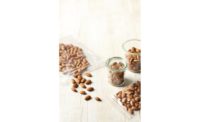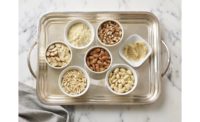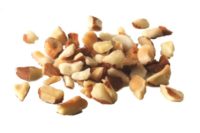When it comes to snacking to help you push through the morning slog, what you choose to eat can make or break your morning and impact how you eat the rest of the day. A new study[1], funded by the Almond Board of California, showed that a morning snack of almonds (compared to a common high-carbohydrate option) helped keep blood sugar levels more stable and trimmed the number of calories eaten over the course of the day.
In this study of 100 New Zealand adults aged 18–65 years, participants ate either at least 42.5g (1.5 ounces) of unroasted almonds or a calorie-matched sweet biscuit snack (the most popular usual snack according to a survey). Both snacks accounted for 10 percent of total calorie intake, so in some cases, the amount of snack consumed was higher.
This study had a randomized crossover design, meaning that each participant completed the study eating the almond snack and then repeated the study eating the biscuit snack on a separate day, or vice versa, with a washout period between each treatment. On the test day, participants ate a standardized breakfast. Two hours later, they ate their assigned snack food. Blood glucose and appetite ratings were measured at baseline and at 15 or 30-minute intervals after they finished eating. Two hours after the snack, lunch was offered to participants, who ate as much or as little as desired and consumption was recorded. Participants then recorded their food intake for the remainder of the day.
Results showed that the blood sugar response was lower among participants after the almond snack versus the biscuit snack. Appetite ratings did not differ between groups except for the appetite score at 90 minutes, which was lower for the biscuits compared to the almonds (which was unexpected since the almond snack resulted in a more stable blood sugar response).
There were no differences in the amount of calories eaten at lunch after the almond or biscuit snacks. However, based on the participants’ food intake records, those who ate the almond snack reported eating ~150 calories less (on average) over the course of the day. If sustained, this calorie deficit could theoretically result in approximately half a kilo (about a pound) of weight loss per month.
This single-day analysis is part of a year-long study examining the long-term implications on weight management. Observations from this acute study are consistent with results from a previous study[2] published in the European Journal of Nutrition. Researchers found that a mid-morning snack of almonds (42g or 1.5 ounces), compared to no snack, helped control appetite and resulted in fewer calories eaten at lunch and dinner. Results of this previous study suggest that rather than skipping out on a snack, eating almonds as a mid-morning snack may help curb hunger.
“Our results showed how eating almonds as a snack in the morning resulted in participants spontaneously consuming fewer calories over the course of the day,” said Dr. Rachel Brown, lead researcher and professor at the Department of Human Nutrition, University of Otago. “Also, our study showed that almonds tempered the post-snack blood sugar response. This is important because consistently high blood sugar levels after eating a snack or a meal may be associated with increased risk for heart disease and for death from all causes, whether a person has type 2 diabetes or not.”
Almonds provide fiber (3.5 g per 30g serving) and 15 essential nutrients including (per 30g serving): magnesium (81 mg), potassium (220 mg), and vitamin E (7.7 mg), making them a perfect nutrient-rich snack. One serving of almonds (28g) has 13g of good unsaturated fat and only 1g of saturated fat.
[1] Brown R, Ware L, Gray AR, Chisholm A, Tey SL. Snacking on Almonds Lowers Glycaemia and Energy Intake Compared to a Popular High-Carbohydrate Snack Food: An Acute Randomised Crossover Study. Int J Environ Res Public Health. 2021;18(20):10989. Published 2021 Oct 19. doi:10.3390/ijerph182010989
[2] Hull S, et al. A mid-morning snack generates satiety and appropriate adjustment of subsequent food intake in healthy women. European Journal of Nutrition. 2015;54(5):803-10.




